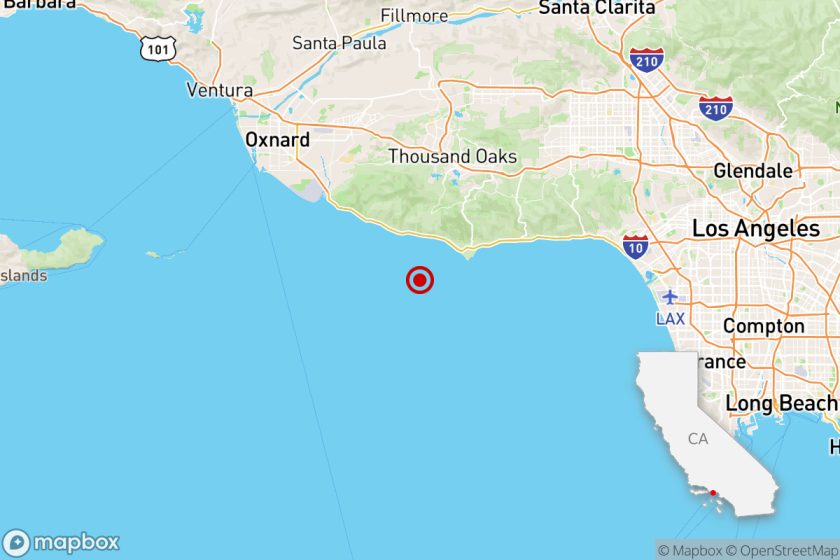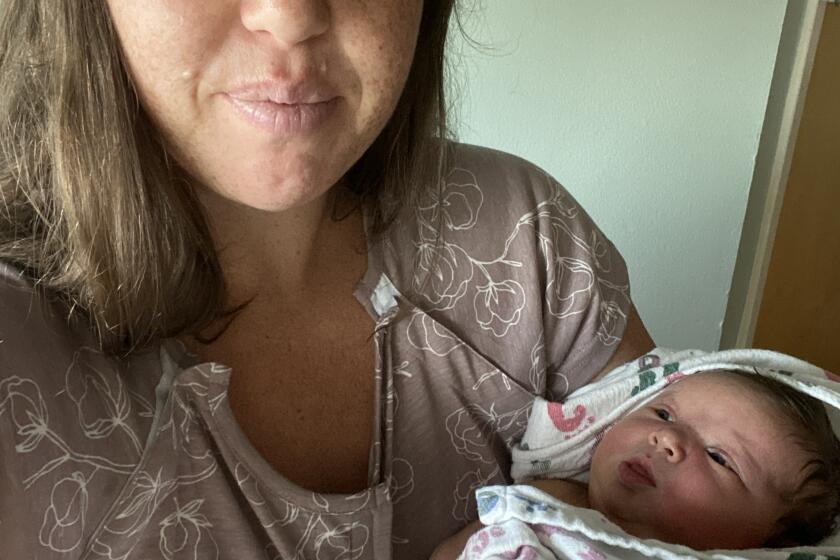Re-Righting History : Landmark Cemetery Undergoes Quake Damage Repairs
At first glance, the toppled gravestones and cracked statuary trigger the worst fears in some visitors to the oldest Jewish cemetery in Los Angeles. But no, Carol Bova, manager of Home of Peace Memorial Park, must explain repeatedly, anti-Semitic vandals did not rampage through the Eastside burial ground.
Instead, she says, the villains were shock waves of the Jan. 17 earthquake, which rolled through the historic cemetery even though it is about 25 miles from the quake’s epicenter. Now the permanent home of Los Angeles’ first Jewish settlers and of many Hollywood movie pioneers is being put back together with local and nationwide help.
“When you have something that’s of such historic importance, you are holding it in trust not only for the past but for the future too,” said Bova, a friendly woman who pauses to pluck out any graveside weeds. “You’re preserving the memorials so that people in the future will know the past.”
That’s going to be a tall order at Home of Peace, 32 acres of palm trees, fountains and memories at the intersection of Whittier Boulevard and the Long Beach Freeway. The price tag will top $300,000, complicated by the fact that many logical donors--children and grandchildren of the buried--are also deceased or cannot be contacted.
The quake toppled 438 granite and marble headstones that had been put in place between the 1920s and the 1950s. All but 150 of the headstones have been reset on their concrete bases with earthquake-resistant epoxies, and the others are expected to be righted in time for the Jewish High Holy Days in September, a traditional time for visits to relatives’ graves.
Repairs also are under way on the 80 stained-glass skylight panels that hung in the large Moorish-style mausoleum on the grounds. Cracked in the quake, the windows had cast tinted light on crypts and urns of such famous people as MGM studio chief Louis B. Mayer, Universal Studios founder Carl Laemmle and entertainer Fanny Brice (portrayed by Barbra Streisand in “Funny Girl”).
But work may take much longer for about 300 grave markers and tall monuments from the late 19th Century that were twisted or otherwise damaged.
*
For example, a six-foot obelisk is oddly out of kilter at the family plot of Solomon Lazard, the French-born merchant and insurance broker who was elected to the Los Angeles City Council in 1854 and served as president of the original Los Angeles Chamber of Commerce. The crowning urn was knocked off the steep memorial pillar for Moritz Morris, a vineyard owner who helped found the city’s first synagogue and served on the City Council in the 1860s. A marble angel crashed, its head sliced off its torso, from the monument to two young girls in a family named Cohen; one, Pauline, died of a skull fracture in 1890, and her sister Etta succumbed to diphtheria in 1891, according to handwritten, 19th-Century files.
Home of Peace is significant because “it contains the monuments that point to so much of Jewish life and contributions in this entire region, from the most famous to the most everyday person,” said Stephen Sass, an attorney who is president of the Jewish Historical Society of Southern California.
What is also unusual, Sass said, is that the cemetery accommodates contrasting customs although it is owned by the Wilshire Boulevard Temple, a Reform congregation that began Downtown as Congregation B’nai B’rith in 1862. Home of Peace has sections for the concrete-covered graves favored by Orthodox Jews and other sections for cremation urns; cremation is forbidden in Orthodox Judaism.
Many other cemeteries in the region suffered less damage in January because they have more graves marked by plaques in the ground, not upright headstones, industry experts said. Also, Home of Peace is on lowlands that may have softer soil from ancient streams below. In contrast, Calvary Cemetery, a Roman Catholic institution just across Whittier Boulevard on more hilly and rocky terrain, was little affected by the quake.
*
None of the bodies or remains were disturbed at Home of Peace and the overwhelming majority of the estimated 50,000 grave markers and urns were not affected, said Stephen Breuer, executive director of the Wilshire Boulevard Temple. The congregation’s first professional rabbi, Abraham Edelman, is buried there, as is Rabbi Edgar F. Magnin, who led the temple to national prominence from the 1920s through the 1980s.
Except on Saturdays, when the cemetery is closed for the Sabbath, tourists can view the grave of Jerome (Curly) Howard and the crypt of his brother Shemp, both of whom were part of the Three Stooges comedy act at various times. Visitors can peer into the imposing mausoleum of movie mogul Harry M. Warner and find the underground crypt of his brother Jack Warner, separated by 50 yards in death after a bitter family feud in life.
“It seems so tied in with the development and growth of Hollywood,” said Tom Randall, co-author of “Permanent Californians,” a 1989 guidebook to California cemeteries. His chapter on Home of Peace begins with a quote from Samuel Goldwyn about the dictatorial Louis Mayer: “The reason so many people showed up at his funeral was because they wanted to make sure that he was dead.”
The cemetery was established in 1855 as the Hebrew Benevolent Society burial grounds in Chavez Ravine, near what is now Dodger Stadium. At the time, rough-and-tumble Los Angeles was home to about 60 Jews who had journeyed from Germany, Austria, Poland and France to unimaginable freedom and success. As industry grew near Downtown, their hilly, three-acre graveyard became surrounded by polluting oil wells and brick kilns. So between 1902 and 1910, all 360 bodies were exhumed and the monuments were moved by horse and wagon to the current site.
The Eastside burial ground became very popular because it was so close to the emerging Jewish neighborhood in Boyle Heights. Today, a generation after Jewish life shifted to the Westside and the San Fernando Valley, Home of Peace continues to add about 250 graves each year, officials say.
The Jewish community’s exodus from Boyle Heights, along with other moves over time, makes it nearly impossible to track down surviving members of families that own monuments damaged in January. Few people, it seems, send change-of-address cards to cemeteries, Bova said as she flipped through burial files that record the heartbreak of influenza and tuberculosis epidemics a century or more ago.
Insurance will cover some of the skylight repairs, but there are no Federal Emergency Management Agency grants for cemeteries. So the cemetery is paying for the first round of repairs with its regular operating budget, reserve funds and donations from temple members and other concerned individuals and organizations, according to Breuer.
As other donations come in, work will be done on the older monuments that shifted and cracked, he said. “Not all those towers may be done but we will do the best we can,” he said.
*
Among the major donors so far, he said, are the Jewish Federation Council of Greater Los Angeles, a consortium of many religious and social welfare groups; the Union of American Hebrew Congregations, the national Reform Judaism organization and Wells Fargo Bank.
“L.A. has a reputation as being new and devoid of tradition,” said Jay Schuster, a spokesman for the Jewish Federation. “We feel it’s important to maintain some of our past.” Besides, he added, taking care of graves is considered one of the most blessed mitzvahs, or good deeds, since the beneficiary is in no position to return any favor.
Many cemeteries around the world do nothing if natural disasters cause damage and the families cannot be found, said Randall, who with his wife, Judi Culbertson, has written other books about cemeteries in New York, London and Paris. Randall said he is impressed that efforts are under way to fix the Home of Peace monuments.
Clearly, Bova wants things back in shape at Home of Peace as soon as possible. During a tour of the cemetery, she stopped to pick up the cracked angel head from the young Cohen girls’ monument and stroked the cherubic face.
“There are folks here who don’t have anyone else to look after them,” she said, wearing a straw sun hat tied with a funereal black scarf. “We look after them as if they were our own.”
More to Read
Sign up for Essential California
The most important California stories and recommendations in your inbox every morning.
You may occasionally receive promotional content from the Los Angeles Times.











